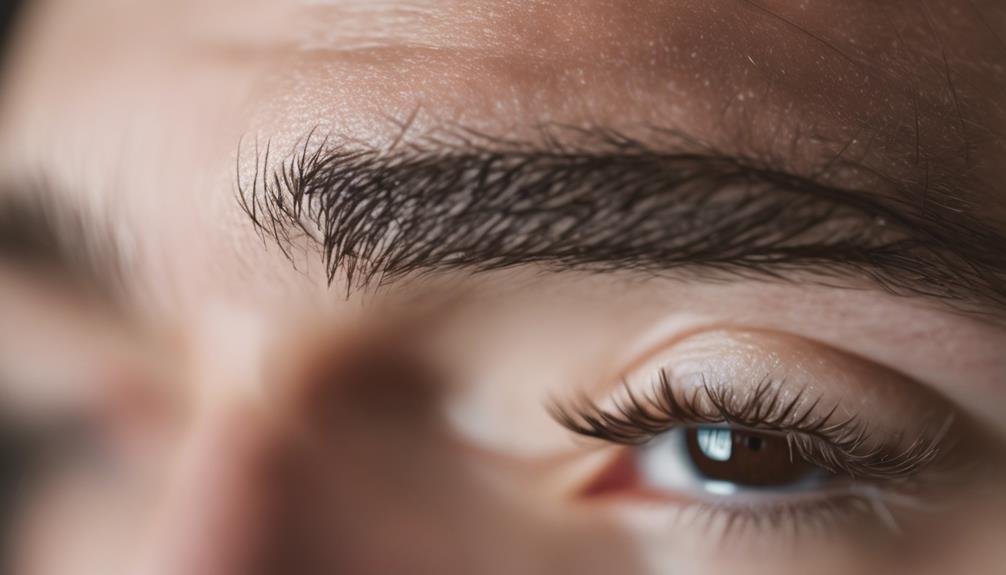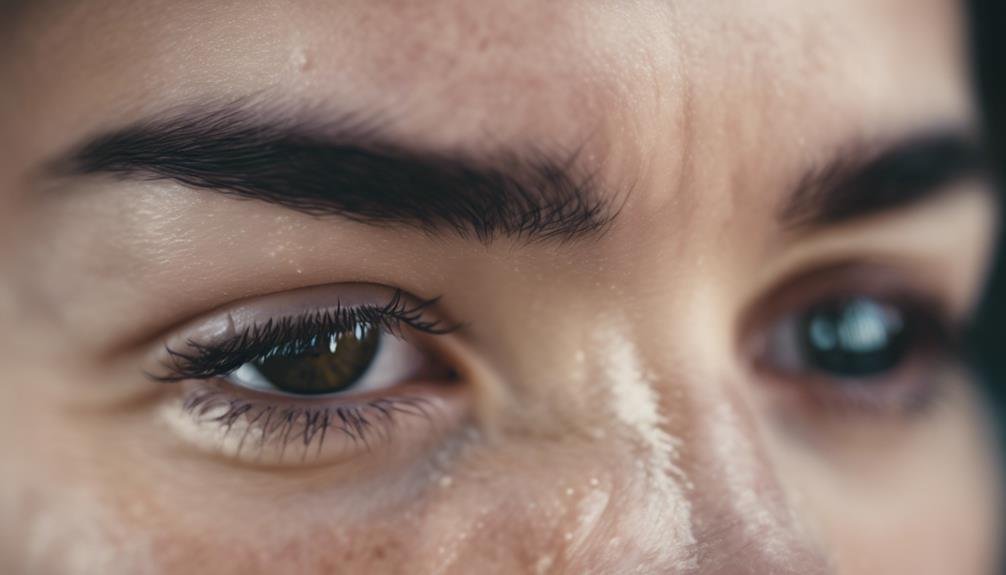When you decide to create an eyebrow slit, you might wonder how long it will take for it to grow back. Generally, this process can take anywhere from 2 to 4 weeks, but it varies based on factors like age, genetics, and the depth of the cut. While it’s natural to feel impatient, understanding the growth phases of your eyebrows can help you manage your expectations. Have you ever considered how overplucking might impact this timeline or what steps you can take to guarantee healthier regrowth? Let’s explore these aspects further to help you achieve the best results.
Key Takeaways
- Eyebrow slit regrowth typically takes 2 to 4 weeks.
- Individual growth rates and genetics can influence the regrowth time.
- Age can impact the speed of eyebrow slit regrowth.
- Proper care and patience are crucial for successful regrowth.
- Avoid damaging the eyebrows during the regrowth phase.
Phases of Eyebrow Growth

Eyebrow growth occurs in three phases: Anagen, Catagen, and Telogen. Each phase plays an important role in the life cycle of your eyebrow hair. During the Anagen Phase, your eyebrows actively grow, with follicles working hard to produce new hair. This phase lasts around 1 to 2 months.
Following the Anagen Phase is the Catagen, a brief intermediary period. Here, the follicles begin to shrink, and the rapid growth you saw in the Anagen Phase slows down. This phase only lasts a few weeks. During this time, your eyebrow hairs are preparing to enter the next stage.
Finally, there’s the Telogen Phase, a resting period for your follicles. This phase lasts between 2 and 4 months, when your eyebrow hairs stop growing and become more prone to falling out. Don’t worry, though; this is completely normal.
After the Telogen Phase, the cycle starts over again. New hairs begin to grow, replacing the old ones that have fallen out. This ongoing cycle of Anagen, Catagen, and Telogen phases ensures continuous eyebrow growth, influenced by genetics, age, and health.
Anagen Phase
Understanding how your eyebrows grow starts with the anagen phase, where new hairs actively develop and emerge. This phase is important for eyebrow slits, as it marks the beginning of new eyebrow hairs. The anagen phase lasts 1 to 2 months and is characterized by rapid cell production. During this time, your eyebrows grow at around 0.16 millimeters per day.
Since the anagen phase is the initial stage, it sets the foundation for how quickly your eyebrow slits will fill in. The growth rate and cell production are pivotal in this phase, ensuring that new hairs emerge robustly. Here’s a breakdown of key factors:
| Factor | Details | Relevance |
|---|---|---|
| Duration | 1 to 2 months | Sets the regrowth timeline |
| Growth Rate | 0.16 mm per day | Determines speed of growth |
| Cell Production | High | Essential for new hair growth |
| Hair Emergence | Active | Critical for filling slits |
| Phase Importance | Initial growth staging | Predicts regrowth time |
Understanding these aspects helps you predict how long it will take for your eyebrow slits to grow back. The anagen phase’s efficiency directly impacts the visible regrowth of your eyebrow hairs, making it an essential part of the hair growth cycle.
Catagen Phase

The catagen phase, where your hair follicles shrink and growth decelerates, typically lasts for a few weeks before progressing into the telogen phase. During this period, the follicles undergo significant changes that are important for the natural eyebrow growth cycle. Although the catagen phase is relatively short, it’s essential for preparing your eyebrows for the next stages of the growth cycle.
In this phase, the follicles shrink and detach from the blood supply, leading to a slowdown in hair production. This shrinking process signifies that your eyebrows are getting ready for rest and eventual shedding. While this might sound like a setback, it’s a critical step in ensuring that new, healthier hairs can grow in place of the old ones.
Understanding the catagen phase helps you predict the regrowth timeline for an eyebrow slit. Since this phase is a precursor to shedding, it’s integral to the eyebrow growth cycle. By knowing how long the catagen phase lasts, you can better estimate when you’ll start seeing new hair growth in your eyebrow slit, setting the stage for the next phase in the regrowth process.
Telogen Phase
In the telogen phase, your eyebrows enter a resting period where old hairs halt their growth and prepare to shed. During this phase, which typically lasts 2 to 4 months, your eyebrow follicles aren’t actively producing new hairs. Instead, they’re taking a break, allowing for the shedding of old hairs to make way for new growth. This phase is important in the eyebrow growth cycle as it marks a period of transformation and renewal for the follicles.
As your old eyebrow hairs fall out, new hairs eventually replace them—this continuous cycle of shedding and renewal guarantees that your eyebrows remain full over time.
It’s important to recognize that genetics, age, and overall health can influence how effectively your follicles go through the telogen phase. If your body is healthy and well-nourished, your eyebrows are more likely to experience a smooth transformation through this resting period.
Understanding the telogen phase helps you appreciate the natural process your eyebrows undergo. While it might be frustrating to wait for an eyebrow slit to grow back, knowing that this phase is an essential part of the growth cycle can offer some reassurance.
Stages of Regrowth

Regrowth of eyebrow slits goes through several distinct stages, each crucial for achieving full restoration. First, you’ll notice the initial fine hairs emerging from the slit, typically within the first week. These tiny hairs signal the beginning of the regrowth process.
Next, the slit area fills in with slightly thicker hairs. You might still see some gaps during this stage, but don’t worry; this is normal. Your growth rate can influence the regrowth time here.
Then, the third stage is marked by the hairs becoming more uniform in texture and color. At this point, patience is key since factors like age and genetics play a role. Finally, the eyebrow slit should fully restore, blending seamlessly with the rest of your brow.
Here’s a brief overview of the stages:
- Initial fine hairs – Appearing within the first week.
- Thicker hair filling – Filling in gaps, influenced by individual growth rate.
- Uniform texture and color – Patience is needed; age and genetics matter.
- Full restoration – Eyebrow slit blends seamlessly.
Proper care throughout these stages ensures the best results. To support successful regrowth, avoid further damage, and maintain overall eyebrow health.
Influencing Factors
Several factors can greatly impact how quickly your eyebrow slit regrows. First, your growth rate plays a significant role. Some people naturally have faster hair growth, while others may find it takes a bit longer. Age is another important factor. Younger individuals often experience quicker regrowth, whereas older people might notice a slower process.
Genetics also come into play. If your family tends to have thick, fast-growing hair, you might see your eyebrow slit filling in more rapidly. Conversely, your regrowth process could be prolonged your regrowth process could be prolonged if thin or slow-growing hair runs in your family.
The depth of the slit is another key element. A superficial cut may heal and regrow faster than a deeper one, which can take longer to fill in. The deeper the slit, the more damage to the hair follicles and the longer it may take for the hairs to grow back.
Patience is essential during the regrowth process. While speeding things up is tempting, letting your eyebrows heal naturally is the best approach. This will avoid further damage to the area and allow for a natural, gradual regrowth process.
Impact of Overplucking

While understanding the influencing factors of eyebrow slit regrowth is important, overplucking can greatly impact the health and appearance of your eyebrows. When you frequently pluck your eyebrows, you risk causing more harm than good. Overplucking can lead to thinning and sparse areas, making it challenging for your eyebrows to grow back to their full, natural state.
Repeated hair removal can alter growth patterns, resulting in uneven or patchy regrowth. This is because the hair follicles become damaged over time. Damaged follicles can lead to delayed regrowth or, in some cases, complete hair loss in specific areas of your eyebrows. This means that even if you stop plucking, your eyebrows mightn’t return to their original thickness or shape.
Imagine the following impacts of overplucking:
- Thinning Eyebrows: Continuous plucking results in fewer hairs growing back.
- Sparse Patches: You may notice gaps where hair used to be.
- Altered Growth Patterns: Your eyebrows might grow back unevenly or in unexpected directions.
- Delayed Regrowth: Damaged follicles can significantly slow down the regrowth process.
To avoid these issues, pluck sparingly and give your eyebrows time to recover between grooming sessions.
Regrowth Timeline
Understanding how long it takes for an eyebrow slit to grow back can help you manage expectations and plan your grooming routine effectively. Typically, the regrowth timeline for an eyebrow slit ranges from 2 to 4 weeks. However, this can vary based on several individual factors, such as the natural growth rate of your hair and the depth of the slit.
Factors like age and genetics also play a significant role. Younger individuals or those with a faster hair growth rate may notice quicker regrowth, while others might need more time. Maintaining patience during this period is important, as rushing or frequently checking the progress can lead to frustration.
Moreover, ensuring that you don’t damage the eyebrows during the regrowth timeline is essential. Overhandling or trying to fill in the slit with makeup excessively can hinder the natural process. Let the hair follicles recover and produce new hair without unnecessary interference.
Success Stories

Many people have shared their eyebrow slit regrowth success stories, showcasing impressive results within weeks to months. They’ve seen visible improvements by committing to consistent regrowth efforts and incorporating recommended products. These success stories often highlight the vital role of patience and the right regrowth strategies.
Here are some common themes from these success stories:
- Consistent Application of Serums: Users regularly applied eyelash and brow serums, which helped stimulate hair growth, resulting in noticeable changes within 3 to 6 months.
- Balanced Diet and Hydration: Many found that a healthy diet rich in vitamins and minerals and staying hydrated significantly enhanced their regrowth efforts.
- Avoiding Over-Plucking: To prevent further damage, they avoided over-plucking or waxing the brow area, allowing the hair to grow naturally.
- Regular Grooming: Gentle grooming techniques, such as brushing the eyebrows daily, help distribute natural oils and promote healthier growth.
Maintaining Healthy Brows
To maintain healthy brows, following a consistent care routine that supports natural growth and prevents damage is important. Start by being gentle; avoid over-plucking or using harsh chemicals. Understanding that regrowth duration varies due to individual growth rates, influenced by age and genetics is crucial.
Maintaining healthy brows means giving them the nourishment they need. Regularly apply a nourishing eyebrow serum or natural oils like castor oil to promote growth. Patience is crucial, as eyebrow slits can take 2 to 4 weeks to grow back, sometimes longer, depending on the depth of the slit and individual growth rates.
Avoiding damage is key. Refrain from rubbing or scratching your brows excessively. If you’re unsure about the best care practices, consult professionals who can provide personalized advice and treatments to support healthy regrowth. Here’s a table to keep you motivated:
| Step | Emotion | Action |
|---|---|---|
| Gentle Handling | Calm | Avoid over-plucking |
| Nourishing Serums | Hopeful | Apply regularly |
| Professional Consultation | Confident | Seek expert advice |
Conclusion
To wrap up, regrowing an eyebrow slit can take anywhere from 2 to 4 weeks, depending on your factors.
Stay patient and avoid over-plucking during this period to guarantee your brows grow back uniformly.
Stick to a consistent care routine to promote healthier and quicker regrowth.
Remember, everyone’s hair growth rate is different, but with proper care, you’ll have your eyebrows back soon.
Stay positive and committed to maintaining healthy brows!
